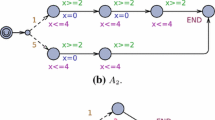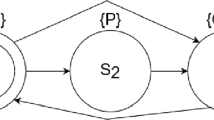Abstract
In this paper, a method for writing composable TLA+ specifications that conform to the formal model called Masaccio is introduced. Specifications are organized in TLA+ modules that correspond to Masaccio components by means of a trace-based semantics. Hierarchical TLA+ specifications are built from atomic component specifications by parallel and serial composition that can be arbitrary nested. While the rule of parallel composition is a variation of the classical joint-action composition, the authors do not know about a reuse method for the TLA+ that systematically employs the presented kind of a serial composition. By combining these two composition rules and assuming only the noninterleaving synchronous mode of an execution, the concurrent, sequential, and timed compositionality is achieved.
Similar content being viewed by others
References
Abadi M, Lamport L (1993) Composing specifications. ACM Trans Programming Languages and Systems 15(1): 73–132
Abadi M, Lamport L (1993) Conjoining specifications. Research Report 118, Digital Equipment Corporation
Abadi M, Merz S (1995) An abstract account of composition. In: Wiedermann J, Hajek P (eds) Mathematical foundations of computer science. Lecture notes in computer science, vol 969. Springer, Prague, pp 499–508
Cousot P, Cousot R (2001) Verification of embedded software: problems and perspectives. Lect Notes Comput Sci 2211: 97–114
Diaconescu R, Futatsugi K, Iida S (1999) Component-based algebraic specification and verification in cafeobj. In: FM’99—formal methods. Lecture notes in computer science, vol 1709. Springer, Heidelberg, pp 1644–1663
Ghosal A, Henzinger TA, Iercan D, Kirsch C, Sangiovanni-Vincentelli AL (2006) Hierarchical timing language. Technical Report Technical Report No. UCB/EECS-20, EECS Department, University of California, Berkeley, May 2006
Henzinger TA (2000) Masaccio: a formal model for embedded components. In: TCS ’00: Proceedings of the international conference IFIP on theoretical computer science. Exploring new frontiers of theoretical informatics. Springer, London, pp 549–563
Henzinger TA, Horowitz B, Kirsch CM (2001) Giotto: a time-triggered language for embedded programming. Lect Notes Comput Sci 2211:166+
Henzinger TA, Minea M, Prabbu V (2001) Hybrid systems: computation and control. Lecture notes in computer science, vol 2034/2001, chap assume-guarantee reasoning for hierarchical hybrid systems. Springer, Berlin, pp 275–290
Herrmann P, Graw G, Krumm H (1998) Compositional specification and structured verification of hybrid systems in ctla. In: Proceedings of first IEEE international symposium on object-oriented real-time distributed computing. IEEE Computer Society Press, Washington, DC, pp 335–340
Hooman J (1993) A compositional approach to the design of hybrid systems. In: Hybrid systems. Springer, London, pp 121–148
Kaminski M, Yariv Y (2001) A real-time semantics of temporal logic of actions. J Logic Comput 13(6): 921–937
Kopetz H (2002) Real-time systems: design principles for distributed embedded applications. The Springer international series in engineering and computer science, vol 395, chap the time-triggered architecture. Springer Netherlands, pp 285–297
Koymans R, Shyamasundar RK, de Roever WP, Gerth R, Arun-Kumar S (1988) Compositional semantics for real-time distributed computing. Inf Comput 79(3): 210–256
Lamport L (1992) Hybrid systems in tla+. In: Hybrid systems. Lecture notes in computer science, vol 736. Springer, Heidelberg, pp 77–102
Lamport L (2003) Specifying systems: the TLA+ language and tools for hardware and software engineers. Addison-Wesley, Reading
Lau K-K, Ukis V, Velasco P, Wang Z (2006) A component model for separation of control flow from computation in component-based systems. Electron Notes Theor Comput Sci 163(1): 57–69
Lee EA (2002) Embedded software. Adv Comput 56: 56–97
Lynch N, Segala R, Vaandrager F (1996) Hybrid i/o automata. Springer, Heidelberg, pp 496–510
Ramakrishna YS, Shyamasundar RK (1995) A compositional semantics of esterel in duration calculus. In: Proceedings of second AMAST workshop on real-time systems: models and proofs. Springer, Bordeux
Rysavy O, Rab J (2008) A component-based approach to verification of embedded control systems using tla. In: IEEE Proceedings of international multiconference on computer science and information technology. IEEE Computer Society Press, Washington, DC, pp 719–725
Author information
Authors and Affiliations
Corresponding author
Rights and permissions
About this article
Cite this article
Rysavy, O., Rab, J. A formal model of composing components: the TLA+ approach. Innovations Syst Softw Eng (2009). https://doi.org/10.1007/s11334-009-0087-2
Received:
Accepted:
Published:
DOI: https://doi.org/10.1007/s11334-009-0087-2




